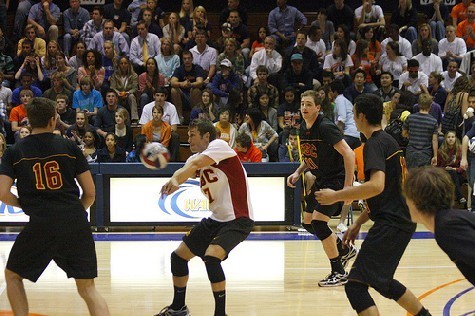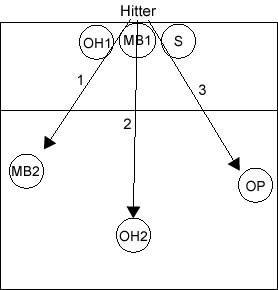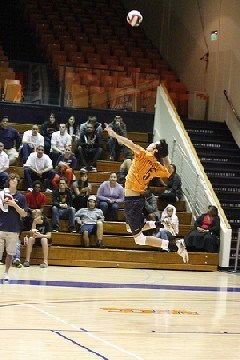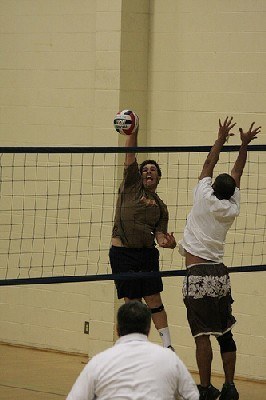Let’s review blocking techniques necessary to be a great blocker. I am a middle blocker and there is nothing I love more than making the other team eat the ball that they just hit at us. What a great feeling to roof someone!
One of the most important things to remember is to get in the right attitude. You must want to be where the ball is and play defense first. Remember that when playing rally point, a good block can be a great offense. It still counts as a point as well as frustrating the hitters on the other team.
Before The Play Starts
One very important part of blocking happens before the ball is served. While at the net, it is important to look at the other team and their offense. How many hitters do they have? What offense are they running? Is the setter on the front row or the back row?
Here are the reasons that these things are important. As a blocker, if you see that there are only two hitters, there is one less person for you to worry about. That makes blocking a lot easier. Also, if the setter is on the back row, then you do not need to worry about the setter dumping the ball. If a back row setter dumps the ball, that is a violation. With the setter on the front row, if the pass is tight, you may have to block against the setter to protect against the dump.
The point is, make sure that you know where the other team’s hitters are and where the setter is located.
Positioning
The first part of honing your blocking technique will be to make sure that you get to the position to block the ball. There is a simple phrase that will help you remember what you should be looking at to make sure you get to the right spot.
The phrase is: BALL, SETTER, BALL, HITTER.
The first BALL means that you should be looking to see where the pass is going. If there is a bad pass, some of the setter’s offensive options will be taken away. Frequently on a bad pass, they will not be able to get the ball to the middle so you can be sure that the ball will be going to the outside or back row.
SETTER means to watch where the setter is going and his body position. This will help you read where the setter is going to set so that you can get there before the ball does. The better you get at reading the setter, the better your blocking techniques will become.
The next BALL is to watch where the set is. If the set is tight on the net, blocking is going to be easier. This will also help you to understand whether it is going to be a quick set or a standard set. Watch the BALL!
Finally, HITTER means to watch a couple of things that the hitter is doing. The hitter is going to know the play that was called. Are they approaching quickly, or are they waiting? This will let you know what kind of attack they are planning. Once you have determined what kind of attack they are doing, you want to watch the shoulders of the hitter.
Most hitters are going to hit the same direction of their shoulders. That means as you jump to block, your success rate will increase as you block in the direction of their shoulders.
More Tips
There are a couple of other things to remember when you get up in the air. Make sure your hands penetrate the volleyball net. That means to get your hands over to the other team’s side of the net as much as possible. Many new players will jump to block the ball and be a couple of feet off of the net. The ball will hit their hands and come straight down on their side of the net. Don’t make this mistake and make sure that the ball goes on the other team’s side of the net!
Here is a great example of how to penetrate the net:
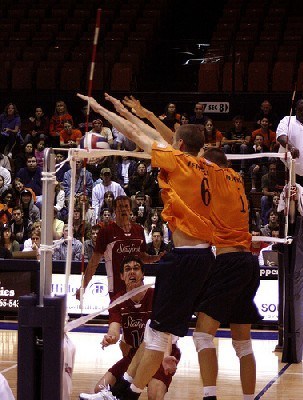
Spread your fingers as wide as possible. You want to try to take up as much area as possible. Keep your hands close enough together that a ball CANNOT go between them. If a ball can go between them, then the hitter could rip one through your hands and the only thing that will stop the ball will be your face. That doesn’t feel good and it certainly won’t impress people. How do you think I know that? 🙂 Yes, I learned some of these blocking techniques the hard way.
If you follow these rules, you will be a great blocker.
The key points for blocking techniques are these:
* Identify the hitters and setters on the other team
* BALL, SETTER, BALL, HITTER
* Penetrate over the net
* Spread your fingers
* Keep the hands close together so you don’t get hit in the face
From there on out, the rest is just practice, practice, practice. These blocking techniques will help you speed up your learning curve.
Where to go next?
Indoor Volleyball Net – Read the reviews and find the best one
Sand Socks – Will they really protect your feet playing on the beach?
Volleyball Scoring – Read more on the various scoring methods for volleyball.

